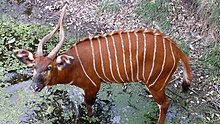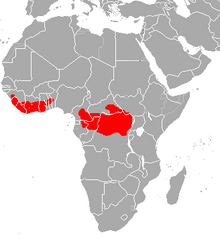| Bongo | |
|---|---|

| |
| Western/lowland bongo at the Marwell Zoo in Hampshire, England | |

| |
| An eastern/mountain bongo at the Jacksonville Zoo, Jacksonville, Duval County | |
| Scientific classification | |
| Domain: | Eukaryota |
| Kingdom: | Animalia |
| Phylum: | Chordata |
| Class: | Mammalia |
| Order: | Artiodactyla |
| Family: | Bovidae |
| Subfamily: | Bovinae |
| Genus: | Tragelaphus |
| Species: | T. eurycerus
|
| Binomial name | |
| Tragelaphus eurycerus (Ogilby, 1837)
| |
| Subspecies | |
| |

| |
| Lowland bongo range | |

| |
| Mountain bongo range | |
The bongo (Tragelaphus eurycerus) is a large, mostly nocturnal, forest-dwelling antelope, native to sub-Saharan Africa. Bongos are characterised by a striking reddish-brown coat, black and white markings, white-yellow stripes, and long slightly spiralled horns. It is the only tragelaphid in which both sexes have horns. Bongos have a complex social interaction and are found in African dense forest mosaics. They are the third-largest antelope in the world.[3]
The western or lowland bongo, T. e. eurycerus, faces an ongoing population decline, and the IUCN Antelope Specialist Group considers it to be Near Threatened on the conservation status scale.[2]
The eastern or mountain bongo, T. e. isaaci, of Kenya, has a coat even more vibrant than that of T. e. eurycerus. The mountain bongo is only found in the wild in a few mountain regions of central Kenya. This bongo is classified by the IUCN Antelope Specialist Group as Critically Endangered, with fewer individuals in the wild than in captivity (where it breeds readily).[4]
In 2000, the Association of Zoos and Aquariums in the USA (AZA) upgraded the bongo to a Species Survival Plan participant and in 2006 added the Bongo Restoration to Mount Kenya Project to its list of the Top Ten Wildlife Conservation Success Stories of the year. However, in 2013, it seems, these successes have been compromised by reports of possibly only 100 mountain bongos left in the wild due to logging and poaching.
- ^ IUCN SSC Antelope Specialist Group. (2017) [errata version of 2016 assessment]. "Tragelaphus eurycerus". IUCN Red List of Threatened Species. 2016: e.T22047A115164600. Retrieved 24 October 2020.
- ^ a b IUCN SSC Antelope Specialist Group. (2017). "Tragelaphus eurycerus ssp. eurycerus". IUCN Red List of Threatened Species. 2017: e.T22058A50197275. doi:10.2305/IUCN.UK.2017-2.RLTS.T22058A50197275.en. Retrieved 24 October 2020.
- ^ Estes, Richard. "Bongo". www.britannica.com. Retrieved 11 March 2021.
- ^ IUCN SSC Antelope Specialist Group. (2017). "Tragelaphus eurycerus ssp. isaaci". IUCN Red List of Threatened Species. 2017: e.T22057A50197212. doi:10.2305/IUCN.UK.2017-2.RLTS.T22057A50197212.en. Retrieved 24 October 2020.
